June 6, 1944, D-Day, would be one that forever changed the world. For months, Americans, British, Australian, Canadian, French, and other Allied Powers trained for months when they would invade the Western Front and help turn that Nazi Germans back. The risks, sacrifices, and dividends were beyond measure. So is trying to put to words what it’s like to visit such hollowed ground.
[fusion_builder_container hundred_percent=”yes” overflow=”visible”][fusion_builder_row][fusion_builder_column type=”1_1″ background_position=”left top” background_color=”” border_size=”” border_color=”” border_style=”solid” spacing=”yes” background_image=”” background_repeat=”no-repeat” padding=”” margin_top=”0px” margin_bottom=”0px” class=”” id=”” animation_type=”” animation_speed=”0.3″ animation_direction=”left” hide_on_mobile=”no” center_content=”no” min_height=”none”][bctt tweet=”June 6, 1944, D-Day, would be one that forever changed the world.” username=”EducatorsRoom”]
Since being selected with Liam, a former student and incoming high school senior, as one of the 15 teams in the Albert H. Small Normandy Student & Teacher Institute this past December, I’ve been told many things (like “this is going to be life-changing”). I’ve also been asked many more questions. Though I’m pretty extroverted and gregarious, I’ve often been at a loss for words.
And that’s a good thing.
When our group of 30 teachers and students from all corners of the United States finally touched down in Paris’s DeGaulle Airport and traveled three hours north to the small town of Bayeaux, we hardly knew what was in store. We also hardly knew how this week would impact our lives forever.
Day 1: Pegasus Bridge
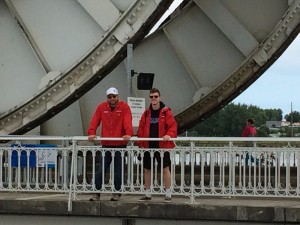
Our journey began at Pegasus Bridge, a seemingly innocuous and simple bridge crossing over the Caen Canal. However, on June 6th, this was one of the most important targets for the British 6th Airborne to secure. Hence its code name (Pegasus) sharing the same name as the division’s symbol. We fought through plenty of sleep deprivation while visiting the museum, climbing through the Atlantic Wall Museum, and meeting one another. But I remember taking a moment that first day, looking up at the bright sunshine on the cool, crisp 65 degree day and thinking just how simple war is on the surface, but how complex it is underneath.
It was a lesson I’d carry with me everywhere we traveled.
Day 2: Ste-Mere-Eglise and Utah Beach
Our next day, we traveled to Sainte-Mere-Eglise. This location was our first taste of where the Americans appeared in the D-Day invasion. We began our day visiting and learning about the church for which the area is named. On the steeple of the church still hangs a replica of Private John Steele, whose parachute tangled upon the tops of the church. If this sounds familiar, you might know his story from John Wayne’s The Longest Day or from the Call of Duty video game series.
Antonin Dehays, our guide and an emerging scholar on the D-Day invasion, wrote his first book on the invasion of the town, so he had plenty to share with us that day. Dr. Dehays explained how poor weather and improvisation scattered the 82nd Airborne on an area 4x where they intended to land. Some fierce battling took place, but Henri-Jean Renaud, the son of the town’s mayor in 1944, explained that his home was on fire and diverted much of the early invasion’s attention.
Down the road we stopped at the Bridge La Fiere, which Dr. Dehays said was aptly named in commemoration of one of the bloodier battles behind D-Day. As I sat there and looked at the map while he laid out the logistics of the haphazard battle, I lost myself from the learning I’m most accustomed to – reading books, textbooks, and listening to podcasts on subject material – I envisioned the soldiers fighting through a storm-raged creek over a one-lane bridge that could be make or break in moving tanks, supplies, and the Germans back.
Next we made our way to Brecourt, which has been owned by the Vallavielle family for more than 400 years. We met Charles, whose father Michel owned the property in 1944, and where 12 members of Easy Company of the 101st Airborne (who starred in Stephen Ambrose’s Band of Brothers book and HBO mini-series) had one of their first daring missions – blowing up 4 cannons being controlled by 60 German soldiers. (If you’ve never watched this scene, it’s my favorite in the entire Band of Brothers series, and I highly recommend it.)
Afterward, I looked at the idyllic pasture that was covered by grazing Norman cows on such another beautiful, crisp day as Charles described how there were many incidents of American heroism that weren’t reported. Conversely, there was a dastardly tale in that his dad was shot in the back 7x by one of the members of Easy Company. Though he had every right to disdain the American troops, when he fully healed and the war was over, he helped establish the first museum to D-Day – that of Utah Beach.
We then boarded the bus and traveled to Utah Beach, which we saw at high tide. When we placed our feet near the sand, we were approximately 20 yards from the water. On June 6th, however, this pristine and empty beach was at low-tide and littered with metal hedgehogs and other obstacles preventing the landing craft and infantry, led by Gen. Theodore Roosevelt Jr., up to face their heavily fortified opponents.
And this was just my second day.
Day 3: Omaha Beach and Pointe du Hoc
We began our morning bright and early by loading the bus and traveling to Normandy. Our group, which had grown together throughout the trip, was unsurprisingly quiet. I tried to put to words what it was like to visit this place, which we met at low tide just like the American soldiers had 72 years prior. It was, without a doubt, one of the most beautiful beaches I’d ever seen. Eeriest of all was the sand, which laid in such a way that it looked like a combination of the tracks of landing craft and footprints.

About 4 miles wide and 1/4 from low tide to road, Omaha Beach was simple and, in the context of beaches, short. I jogged it to see how long it would take me to bridge the water to the road, and I clocked in at 4 minutes, 8 seconds. In comparison, it took the Americans 6 hours just to get that far on June 6, 1944. The famous opening scene of Saving Private Ryan did its best to recapture the gore and sacrifice there, but most veterans who saw the movie and were willing to talk about it said that, despite director Steven Spielberg’s best efforts, was hardly able to do it (see the video here, though beware of graphic footage). I’m not going to pretend I can do any better.
In fact, I’m mostly at a loss for words when it comes to Omaha. There are no places to take a touristy photo. No signs. No remnants of the war. Just a beach that looked a lot like what I imagine the beaches in heaven would look like.
After spending hours (and yet not enough time) at Omaha, we traveled to Pointe du Hoc, where 225 Rangers scaled a cliff to hopefully destroy 6 anti-aircraft guns there. Though, when they arrived, they quickly learned that the guns had been moved inland and the ones sticking out there were fake wooden ones. They also would’ve seen the same landscape we saw there, which was simply dominated by bombardment after bombardment, leaving craters 10 feet in diameter that took a plateau and made it look hilly. It’s here where Liam was given the task of sharing what it was like to be part of those bomber missions, as we’d been taking months studying the life of a tail gunner who was shot down while trying to dismantle the secure German positions through superior air power.
Day 4: Cemeteries of the Dead
Our first encounter with poor weather came at an appropriate time. Our first top was Saint Lo, which Dr. Dehays told us the Americans nicknamed “King of the Rubble.” Nearly 20,000 Normans lost their lives in the bombardments there.
Next we made our way to Marigny German Cemetery, which was quite a contrast to the Allied stops we’ve so far experienced. Dr. Dehays told us ahead of time that the land a fallen German soldier occupies is just 1/28th that of the American soldier, and it wasn’t until 1961 (17 years after the battles) that the Germans were permitted to inter their fallen. As I walked the plots, I saw that approximately 10% or more of the gravestones said “Zwei Deutsche Soldaten,” that of an unknown soldier. While we were there, several Germans were busy trying to raise the tiny stones from the ground that was sucking them in. It was very interesting to talk with them, as they highlighted the difficulty of caring for the dead of the losers.
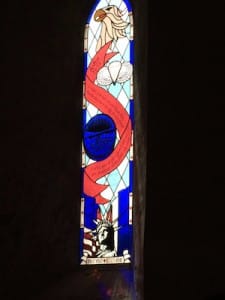
After this spot, we traveled to Angoville-au-Plaine, which many World War II buffs probably gloss over but shouldn’t. I found the lessons here to be the most rewarding of all, as we learned the tale of a 700 year old tree that sat outside a church that held upwards of 80 French civilians who were severely hurt. The 101st Airborne dropped over this spot, and many were killed or taken captive. This includes medics Kenneth J. Moore and Robert E. Wright, who took care of the injured.
Inside, some of the pews in the church are still bloodstained, bearing the town’s sacrifice. The stained glass, on the other hand, bares very patriotic American symbolism one would expect to find in the
church of an American training ground or political retreat. That is, except for the two original stained glass pieces that remained – aptly, those of the angels of the sick and healing.
Still one more day to experience… The day where the students shared their eulogies.
Day 5: Normandy American Cemetery
This is taken directly from my journal that day:
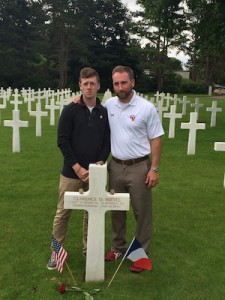
Liam’s was delivered around 2/3 through the eulogies, and he performed masterfully. His message about his GI – Clarence Donald Reeves – will be one both he and I remember for years to come. I thought his focus of the micro- components of this tail-gunners’s life in the 44th air group paired well with the macro-examination of the full on impact of the war on our soldiers, and their families. To think what it’s like to be the “angel” he said that was close to heaven gave us all a visual that will last with us all.
[/fusion_builder_column][/fusion_builder_row][/fusion_builder_container]

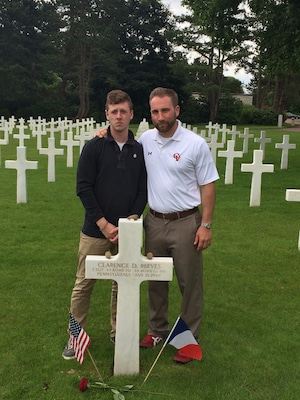

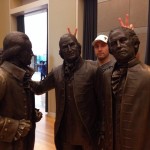


Jake this was incredibly well written, thank you for expressing much that I have not been able too. I find myself STILL feeling overwhelmed. (And I did cry, again, as I read about their eulogies)
Jake,
Thanks for doing this. It was impressive and thoughtful. I appreciate that you documented our trip.
Best wishes,
Janelle Gilson